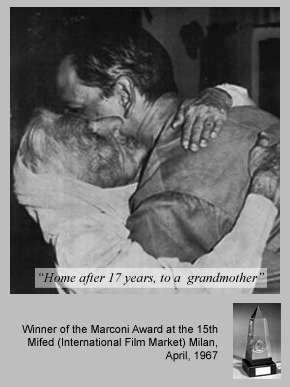India! My India!
A charismatic film by Yavar Abbas | Black-and-white, 1966 | In 4-parts

This is the story of a journey – a deeply personal story of one man who, after seventeen years of self-imposed exile in England, made his pilgrimage back to his native land and his family.
When India gained her independence in 1947 and was partitioned into India and Pakistan, Yavar Abbas saw his dreams for a united free India confounded overnight. Himself a Muslim, he was brought up to believe that the social and political distinctions between Hindus and Muslims were imposed from outside for ends foreign to Indian social thought and history. Rather than live in an unnaturally divided homeland, he brought his wife- an English girl he married in 1947—and infant son to live in England.
In 1964, he went back….” After Seventeen Years”—the first of four half-hour films—introduces us to Abbas’s character and dilemma. It shows us his family in England, his returns to India, his reunion with his family in Charkari, and the faces and scenes of his childhood.
Three subsequent films take Abbas back to his past, to places of his youth and early manhood: to Lucknow, Allahabad University, the Indian Military Academy, to his brother’s Army home in Jhansi; and to his long-lost sister in Patna. In these and other places, he sees something of the old familiar India and not a little of the surprising new. His pilgrimage is linked to his own family, friends, and experiences. ” India! My India!” is one man’s story, one man’s journey, one man’s India.
Eric Davidson in the Radio Times
March 31, 1966
Releases
- BBC Television: April 1966
- BBC Television: November 1966 (Repeat)
- Netherland TV: January 1967
- Indian TV (Delhi): March 1967
Credits
Film and Narrated by: YAVAR ABBAS
Additional Photography: Om Prakash, Jagdish, Ramnik Lekhi
Music: S.D. Batish
Technical Details
PRODUCED and DIRECTED by:
YAVAR ABBAS
Duration: 4:26 minutes
16mm, B&W sound, Optical, Magnetic, Combined or separate
Face Film International Ltd.
16 Dean Road, Hounslow, Middlesex TW3 2EL U.K.
Tel/ Fax: 081-898 6328
…. I was most impressed with it. The whole thing is quite an exhaustive treatment of Modern India. I was extraordinarily impressed by the fact that you have not glossed over anything and have shown the good side, the bright side, the optimistic side as well as some of the remnants of the tragic aspects of India…… the main thing that strikes you, is its truth of observation and its sincerity, I think it is very well shot. It is an excellent job of cutting too; it has got a very good pace, the right sort of pace for this sort of subject. One of the most striking things about the film is its commentary which is so well written, so sparse, so precise and to the point, and nothing sort of over-blown or rhetorical—poetic, simple and, I must say, spoken extremely well by you.
And the contrasts….. I like this sort of contrast because I try to portray the same sort of things in my films. I like the old and new existing side by side and being shown to exist side by side. And this is the one aspect of India that has always fascinated me, although I have restricted myself to Bengal and you have taken in quite an area. Number one, I found most moving, number four most exciting, and there are some lovely things in numbers two and three too. I enjoyed it.
– From an interview recorded in Calcutta on May 21, 1967
What the Papers say about “India! My India!”
…….. the greatest and most refreshing relief
…….. beautiful and memorable shots.
………beautiful poetic commentary full of originality and fertile ideas.
………simple and moving music.
….. a cut above the normal level of documentaries.
January 18, 1967
….. an image of India in as sensitive and penetrating a way as only Abbas could have done….this dedicated film-maker.
January 20, 1967
………. combining the interests of travelogue and filmed autobiography it provides a clearer impression of a country’s development than many a fact-filled documentary.
Few men have spoken so effectively in the first person singular as Mr.Yavar Abbas. He has deservedly won a reputation in the United Kingdom rivalling that of Satyajit Ray.
……an authentic image of India one sees, not the garbled, distorted face that is presented to credulous viewers in the west.
…..Yavar Abbas, that gloriously committed film-maker whose intense reinterpretation of India to himself, makes four of the most vivid documentaries available.
………a sensitive and moving documentary.
The commentary is intelligent, witty and sensible. The film itself is full of the smells and sounds of this ancient, poor and diverse country.
